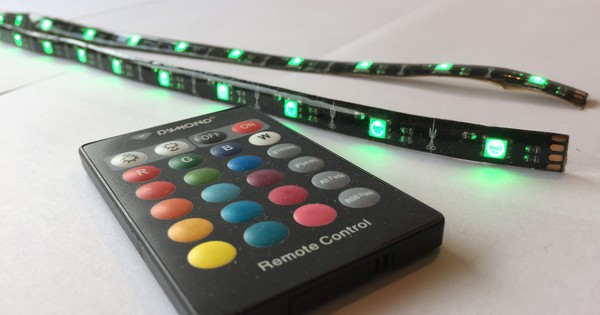With the right instructions, you can turn even the simplest USB printer into a versatile network printer. Handy, because that way you can start a print job from other computers and mobile devices within your network. Use the sharing function in Windows 10, the Google Cloud Print service or the USB port of your NAS for this.
Tip 01: Why share?
USB printers can be connected directly to a laptop or PC via a cable. You can then only print from this computer. A disadvantage, because you may also regularly use a tablet, smartphone or other computer. If you want to print something, you can only do that via the system to which the USB printer is connected. Fortunately, most new printers have a WiFi module and/or wired network connection, so you can easily share the printer with other devices in your home network. Does your (old) printer only have a USB connection? Don't worry, because thanks to smart tips you can still turn this into a network printer.

Tip 02: Share printer
Windows 10 has a printer sharing feature so you can start print jobs from other PCs and laptops. A disadvantage is that this method does not work for smartphones and tablets. Furthermore, the PC to which the USB printer is connected must always be switched on. Successively click on Home / Settings (the gear icon) / Devices / Printers & Scanners and see if you see the name of the usb printer. Click on it and choose To manage. Via the menu option Printer Features a new dialog box will appear. You now open the tab To share, after which you have the option This printerparts ticks. You adjust the so-called share name at your own discretion; this is the network name that identifies the printer on other Windows machines. Then confirm with OK. Open via Home / System the part Control Panel. Type in the search field at the top right Network Center and click on the part of the same name. Choose now Change advanced sharing settings and activate under Private network (current profile) the option if necessary Enable file and printer sharing. End with Saving Changes.

Tip 03: Approach the printer
You can now access the shared printer from other Windows 10 machines. The condition is that you use this computer under the same user account as the system to which the USB printer is connected. You can easily add the printer to another computer. Navigate to Start / Settings / Devices / Printers & Scanners and click Add a printer or scanner. The network name of the shared printer should now appear on the screen. Click on this name and choose Add device. Windows 10 automatically retrieves the correct driver in most cases. Try the connection to the printer by printing.
 Easily use a shared USB printer from other Windows systems
Easily use a shared USB printer from other Windows systems Tip 04: Google Chrome
Under the name Cloud Print, Google also offers a smart solution for making prints from various devices. This is even possible outside your home network! Moreover, this method is also well suited for smartphones and tablets. You need the Chrome browser to add a USB printer to Google Cloud Printer. If necessary, visit www.google.com/chrome to download this program. After installation, log in with a Google account (or with a Gmail address). Don't have an account yet? In that case, go to //accounts.google.com to register yourself.

Tip 05: Google Cloud Print
The next step is to register your USB printer with Google Cloud Print. Open Chrome and type in the address bar chrome://devices. Then press Enter to open the settings. Click on the part Classic printers on Add Printer. Google Cloud Print will now search for the connected print device. Multiple results may even appear, for example if your computer has a virtual printer installed. You put a check in front of the correct printer name, after which you confirm with the blue button Add printer(s).

Tip 06: Print with PC
You can now use any computer that is connected to the internet to start a print job. The condition is that the system and the USB printer connected to it are switched on. Surf to www.google.com/cloudprint with any browser and log in with your Google account. Select the red button at the top left Print and then for Upload file to print. Through Select a file on my computer For example, select a Word or PDF document. After you have designated the correct printer, some print settings will appear on the screen. Set the desired number of prints and the paper size, among other things. You can also activate double-sided printing and select the orientation. Finally, choose Print. In the next screen you can view the progress of the print job.

Tip 07: Desktop program
A driver for Windows is available under the name Google Cloud Printer. Convenient, because you can use this to start printing tasks from your favorite applications, such as Word, Outlook or Adobe Reader, in the regular way. Surf here and click successively Download / Accept and Install Google Cloud Print. You then double click on the exe file to complete the installation. Now print a document from any program and select as printer Google Cloud Print. The Google Cloud Print web environment will now appear. If necessary, log in with your Google account and select the correct printer. Finally, confirm with Print.

Tip 08: Mobile printing
You can also use Google Cloud Print from a smartphone or tablet. On an Android device, you use Cloud Print for this. Once you have installed this application from the Play Store, you can easily send print jobs from apps such as Gallery, Gmail, Chrome and Word. For example, do you want to print a beautiful photo from Gallery? Tap the button with the three dots in the top right and choose Print. At the top, tap Select Printer to designate the correct device. You also enter the number of copies, the paper size and the color. Finally, press the yellow icon to start the print job. One condition is that you use the same Google account for both the Android device and the Cloud Print service. iOS device owners rely on PrintCentral Pro to perform print jobs via Google Cloud Print. This app costs 6.99 euros for the iPhone, while iPad users pay 8.99 euros.
 With Google Cloud Print you can send print jobs from any smartphone or tablet
With Google Cloud Print you can send print jobs from any smartphone or tablet Tip 09: Share Cloud Print
You may share a USB printer that you register with Google Cloud Print with other people. Handy in case other family members also want to control the printing device from different devices. Open Chrome and type again chrome://devices in the address bar. After you press Enter, click after the printer name To manage. Choose the green button at the top To share to invite one or more persons to use this printer. Fill in the email addresses at the bottom for this. Contact suggestions appear as you type, so you usually don't need to enter full addresses. Finally click on To share. All invitees will now receive an email. It states that they can use the shared printer immediately. They decide for themselves whether they accept this request.

Connect to router
Does your router have a USB port? That means good news, because you can probably connect a USB printer directly to this. Computers in your home network then directly access the printer via the print server of your router. The advantage of this method is that a computer does not have to be continuously on to process print jobs. The operation differs per router. The better models automatically recognize a connected USB printer, so you don't have to do anything else. Certain routers, on the other hand, require a firmware update. You may need to add the USB printer manually. You can open the settings for this via the IP address of the router. For exact instructions, please refer to the manual of this network device.

Tip 10: Share via nas
A NAS functions well as a print server, so that all computers can use a USB printer via the home network. We'll show you how to share a printer using a Synology NAS. First, plug the printer's USB cable into a free USB port and open the user interface of your NAS (in our case, DiskStation Manager). It is important that you are logged in as an administrator. Navigate to Control Panel / External Devices / Printer and see if the network device recognizes the connected printer. As soon as you click on the printer name, choose at the top for Printer Management / Printer Setup. Select at the top Network printer and confirm with Save. To add this new-fangled network printer to a Windows machine, you need the Synology Assistant program (www.synology.com/nl-nl/support/download). Within this program, click on the tab Printer device and follow the remaining instructions.


